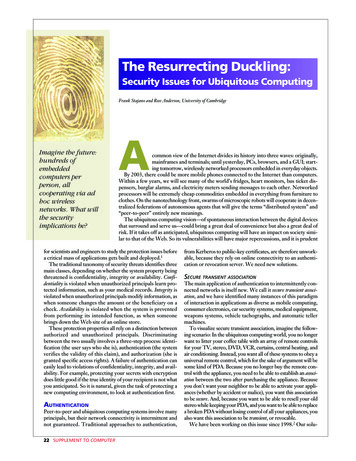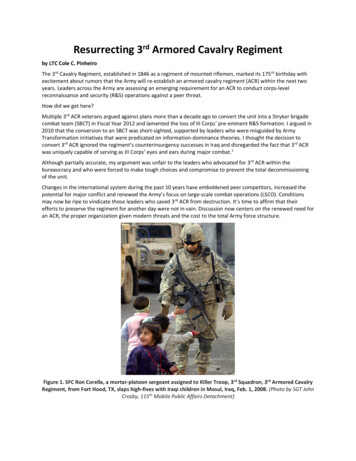
Transcription
The Resurrecting Duckling:Security Issues for Ubiquitous ComputingFrank Stajano and Ross Anderson, University of CambridgeImagine the future:hundreds ofembeddedcomputers perperson, allcooperating via adhoc wirelessnetworks. What willthe securityimplications be?Acommon view of the Internet divides its history into three waves: originally,mainframes and terminals; until yesterday, PCs, browsers, and a GUI; starting tomorrow, wirelessly networked processors embedded in everyday objects.By 2003, there could be more mobile phones connected to the Internet than computers.Within a few years, we will see many of the world’s fridges, heart monitors, bus ticket dispensers, burglar alarms, and electricity meters sending messages to each other. Networkedprocessors will be extremely cheap commodities embedded in everything from furniture toclothes. On the nanotechnology front, swarms of microscopic robots will cooperate in decentralized federations of autonomous agents that will give the terms “distributed system” and“peer-to-peer” entirely new meanings.The ubiquitous computing vision—of spontaneous interaction between the digital devicesthat surround and serve us—could bring a great deal of convenience but also a great deal ofrisk. If it takes off as anticipated, ubiquitous computing will have an impact on society similar to that of the Web. So its vulnerabilities will have major repercussions, and it is prudentfor scientists and engineers to study the protection issues beforea critical mass of applications gets built and deployed.1The traditional taxonomy of security threats identifies threemain classes, depending on whether the system property beingthreatened is confidentiality, integrity or availability. Confidentiality is violated when unauthorized principals learn protected information, such as your medical records. Integrity isviolated when unauthorized principals modify information, aswhen someone changes the amount or the beneficiary on acheck. Availability is violated when the system is preventedfrom performing its intended function, as when someonebrings down the Web site of an online store.These protection properties all rely on a distinction betweenauthorized and unauthorized principals. Discriminatingbetween the two usually involves a three-step process: identification (the user says who she is), authentication (the systemverifies the validity of this claim), and authorization (she isgranted specific access rights). A failure of authentication caneasily lead to violations of confidentiality, integrity, and availability. For example, protecting your secrets with encryptiondoes little good if the true identity of your recipient is not whatyou anticipated. So it is natural, given the task of protecting anew computing environment, to look at authentication first.AUTHENTICATIONPeer-to-peer and ubiquitous computing systems involve manyprincipals, but their network connectivity is intermittent andnot guaranteed. Traditional approaches to authentication,22 SUPPLEMENT TO COMPUTERfrom Kerberos to public-key certificates, are therefore unworkable, because they rely on online connectivity to an authentication or revocation server. We need new solutions.SECURE TRANSIENT ASSOCIATIONThe main application of authentication to intermittently connected networks is itself new. We call it secure transient association, and we have identified many instances of this paradigmof interaction in applications as diverse as mobile computing,consumer electronics, car security systems, medical equipment,weapons systems, vehicle tachographs, and automatic tellermachines.To visualize secure transient association, imagine the following scenario: In the ubiquitous computing world, you no longerwant to litter your coffee table with an array of remote controlsfor your TV, stereo, DVD, VCR, curtains, central heating, andair conditioning. Instead, you want all of these systems to obey auniversal remote control, which for the sake of argument will besome kind of PDA. Because you no longer buy the remote control with the appliance, you need to be able to establish an association between the two after purchasing the appliance. Becauseyou don’t want your neighbor to be able to activate your appliances (whether by accident or malice), you want this associationto be secure. And, because you want to be able to resell your oldstereo while keeping your PDA, and you want to be able to replacea broken PDA without losing control of all your appliances, youalso want this association to be transient, or revocable.We have been working on this issue since 1998.2 Our solu-
The Four Principles of theResurrecting Ducklingtion is a security policy model describing the properties that asystem should possess to implement a satisfactory secure transient association: we call it the Resurrecting Duckling policy.The name was inspired by the work of Konrad Lorenz, theNobel-winning investigator of animal behavior, who describedhow a goose hatchling assumes that the first moving object itsees must be its mother.THE RESURRECTING DUCKLING SECURITY POLICY MODELOur idea is to have a slave device (such as your DVD player)imprint itself to a master (such as your PDA) through the transfer of an imprinting key, or “soul.” Once the slave device, the“duckling,” is imprinted, it remains faithful to the master, its“mother duck,” for as long as that soul persists. When theduckling dies, the soul dissolves, and the duckling’s body isready for imprinting to a new and possibly different motherduck. In other words, a duckling that dies may be resurrectedlater with a different soul. (Adherents of many religions believein metempsychosis—that, on death, the body dissolves and thesoul migrates into a new body. Our proposal might bedescribed as “reverse metempsychosis:” the soul dissolves, andthe body is inhabited by a new soul.)More formally, four principles define the Resurrecting Duckling security policy model: two states, imprinting, death, and assassination. (For definitions of these principles, see the sidebar.)Interestingly, several real-world security artifacts, such as alaptop with a password-protected BIOS, already behave almostlike ducklings; but they do not comply with the assassinationprinciple, and therefore are too easy to subvert. Sometimesthis is a deliberate tradeoff in favor of availability—a means tolet the legitimate owner regain control even if she can nolonger prove that she is the mother duck—but more often it issimply a matter of cost and convenience.3We can extend our policy model to encompass a great variety of relationships between devices.4 The mother-to-duckling relationship is a master-slave one, but sometimes we mightwish the duckling to interact with peers, or to have other masters besides its mother. When we want our camera to ask ourcellphone to use its microphone and A/D conversion facility toannotate photographs vocally, it makes little sense for the camera to become the cellphone’s mother duck; still, we want onedevice to be able to give instructions to the other.The way we address this problem is to introduce a “devicepolicy,” in the style of Policymaker,5 as a level of indirection.The mother duck is the entity that can edit the duckling’sdevice policy, while the device policy itself says which credentials a principal must present for the duckling to perform agiven action for it. This means that we now have two levels ofbeing master: the long-term master is the mother duck, whocan delegate a subset of her powers to another principal oreven to a group of principals along the peer-to-peer model.It is prudent to set some limits, however. If the mother duckallows anyone else to order the duckling to commit suicide,then this delegate might commandeer the duckling withoutthe original mother duck being able to stop him. Allowing yourlocal flower-arranging society to meet in your home every Saturday is one thing; but if you gave every one of its members aThe Resurrecting Duckling security policy model describesa way of establishing a secure transient association betweentwo devices—a master and a slave. Four principles define theResurrecting Duckling: Two states. The duckling can be in one of two states:imprintable or imprinted. In the imprintable state, anyonecan take it over. In the imprinted state, it obeys only itsmother duck. Imprinting. The transition from imprintable to imprintedhappens when the mother duck sends an imprinting keyto the duckling. This must be done using a channel whoseconfidentiality and integrity are adequately protected. Death. The transition back from imprinted to imprintableis known as death, and can only be initiated by an orderfrom the mother duck. Assassination. The duckling must be constructed in such away that it will be uneconomical for an attacker to assassinate it—that is, to cause the duckling’s death artificiallyin circumstances other than the one prescribed by thedeath principle.copy of your house key, you might come home to find that oneof them had changed the cylinder in your absence and lockedyou out. So the ultimate control over most devices will probably be closely held, as a precaution against service-denialattacks by malicious or subverted principals.CONFIDENTIALITYWhen people think about security issues for ubiquitous computing, they first think of eavesdropping as a consequence ofwireless networking. But this concern is vastly exaggerated:once we have solved the hard problem of authenticating theprincipals and sharing key material, we have mature and robustsymmetric ciphers for protecting a communications channel’sconfidentiality. The actual problems are elsewhere.BITS PER SECOND OR BITS PER JOULE?The size and shape of the typical ubiquitous computing deviceimpose new constraints. Untethered devices are battery powered, so they can’t use the fastest and most powerful processorsavailable lest they require extremely frequent recharges (as laptop users know all too well). Many ubiquitous computingdevices therefore have “peanut” processors that are too slowfor computationally intensive tasks such as public-key cryptography.This is well known, and one traditional way of dealing withpeanut processors is to do most of the work as backgroundtasks or as precomputations. But the batteries of miniatureportable devices hold only a small, finite amount of energy;this places a bound on the total amount of computation thedevices can perform, rather than on the rate at which they canperform it. This problem is new and more interesting: to evaluate a cipher (or any other algorithm) on a peanut device (asopposed to a peanut processor), the most relevant performancefigure is no longer bits per second, but bits per joule. (Powerconstraints could favor the introduction of asynchronousSECURITY & PRIVACY–2002 23
processors, which run without a clock and halt when no computation is being performed.)BIOMETRICS, COERCION, TRAFFIC ANALYSIS, AND MOREWhile it is straightforward to protect the confidentiality ofwireless traffic, it is much harder to protect the confidentiality of the information held in the devices themselves. At present, few people worry about this. Most PDAs, for example,which are relatively likely to be lost or stolen, are not evenpassword protected. Even those that are password protecteduse unencrypted storage, and are therefore at the mercy of themoderately resourceful attacker.6 This is hardly surprising, asthe value of the information held in the typical PDA is small,both for the owner and for the potential thief.In the future, however, the ubiquity of computing deviceswill multiply the opportunities for storage of information aboutour activities. Our digital butlers will have as their explicit mis-INTEGRITYThe basic integrity problem is to ensure that messages fromone principal to another are not corrupted by a malicious thirdprincipal. This is similar to confidentiality in that, once weknow how to do authentication and key distribution, the problem is trivial to fix using well understood cryptographic mechanisms, such as message authentication codes. Authenticatingbroadcast data is somewhat trickier if we wish to avoid thepower cost of computing a series of digital signatures, butresearchers have devised several chaining protocols to tacklethis problem.8 The most serious integrity problem for ubiquitous computing, therefore, is once again not with the messages in transit but with the device itself.TAMPER RESISTANCE AND TAMPER EVIDENCEHow can I establish whether a device I am using for communication has been subtly modified or even replaced with a fake?It is easy to recognize this as anauthentication problem, andThe ubiquity of processing and communicating powerthere is a close relationshipwill bring convenience, but also a great deal of risk.between authentication andintegrity. The Duckling solutionsion the job of discovering and remembering as much as pos- may come in handy once again. There is, however, anothersible about our habits and idiosyncrasies. Finally, it would not aspect to the solution—physical tamper protection.The usual assumption underlying authentication is that thebe the first time that a technology infrastructure introducedfor one purpose was misused for another to the detriment of network is insecure and under the control of the attacker, butpersonal privacy—think of credit cards being used to gather that the principals involved are capable of keeping their secrets.Ubiquitous computing takes this assumption and, as it doespurchasing patterns.It is thus important to protect the confidentiality of the data with so many others, turns it on its head: network attacks willheld in at least the mother-duck devices. There are several often be easy to deal with, but attackers are likely to subvertcomponents to this problem. The first is in finding methods many of the principals.Providing high-grade tamper resistance, which makes itthat let users authenticate themselves to the device, whether bya password or a biometric (such as a manuscript signature done impossible for an attacker to access or modify the secrets heldwith the pen on the PDA)—and this is harder than it looks.7 inside a device, is expensive and difficult.9 It is often better toThe second is protecting within the device any long-term keys rely instead on tamper evidence, which ensures that tamperingused to encrypt private data, such as the user’s profile and the attacks leave a visible trace. The main objection to this stratimprinting keys of controlled devices. The third is security egy is that it breaks open the loop of machine-based verificarenewability—the problem of recovering from a PDA theft tion. A physical seal’s integrity cannot be verified as part of thethat occurs while the device is “live” or when the thief has authentication protocol; instead, it requires human inspection.Some might see this as a security hole, but it could actuallyobserved or can guess the owner’s password. (The Ducklingmodel could be part of the solution here.) The fourth is the be an advantage. It means that the responsibility for protection rests with the person relying on that protection, ratherissue of resistance to coercion.Finally, we must consider metadata protection. Anonymity, than with some third party who might have different motives.traceability, and traffic analysis are aspects of confidentiality In addition, managing the protection is also a matter of comthat have so far been underestimated, but they will take on mon sense. Two very common causes of security failure aremuch greater importance in the ubiquitous computing con- that the principal responsible for the security is not the printext. Encryption makes it easy to protect the what of a con- cipal relying on it,7 and that technical mechanisms such as pubversation; but the when, the from, and the to—not to mention lic-key certification are too hard for normal mortals to underthe very fact that a conversation is taking place—remain stand and manage.10 It is somewhat hubristic for engineers toobservable. Defending against traffic analysis is a difficult assume that they must solve all problems using mechanismsproblem, and an active research area. From the user’s point within their realm of professional expertise, when other, simof view, a conscious effort to support location privacy and to pler, mechanisms might be more robust.make a user’s transactions difficult to link to each other isnecessary at the design stage; otherwise the ubiquitous com- AVAILABILITYputing infrastructure will become a tool for ubiquitous sur- The classical attack on a wireless system’s availability is to jamveillance.the communication channel. This problem has been exten-24 SUPPLEMENT TO COMPUTER
sively studied for its military implications,7 and we can recyclemuch of the know-how developed in that field for civilian use.Ubiquitous systems that depend on short-range RF communication will of course fail completely in the presence ofjamming, but the methods for dealing with it lie outside system design: once the jammer moves out of range (or once thepolice take him away), the network can resume normal activity. The more interesting and novel denial-of-service attackemerges from the relationship between security and powerconservation that we mentioned earlier. If a device has limitedbattery energy and tries to sleep as often as possible to conserve it, keeping it awake until this energy runs out can be aneffective and selective attack. Once the battery is flat, theattacker can walk away, leaving the victim disabled. We callthis cruel treatment sleep deprivation torture.You might think that authentication could prevent suchattacks, but this is not always the case. Authentication lets youdistinguish friends from unknowns; but in some applications youcannot refuse to serve unknowns—for example, if you are a Webserver. The dilemma for the server is whether to answer queriesfrom unknowns: they might be staging a denial-of-service attack,but they might be genuinely interested in the answer. Identifying repeat offenders is futile, both because source informationcan easily be faked, and because a villain might subvert multiple“innocent” principals into cooperating in the attack—the socalled DDOS (distributed denial-of-service) attack.When the server has several functions of different importance,we can prioritize them and use a resource allocation strategy tohard-limit the amount of resources that the less-important usescan consume. This guarantees a certain level of service to themore important uses. Of course, this still fails to protect againstsome types of attacks, such as those from authorized insiders.One approach to this problem is what we call plutocratic accesscontrol: you receive service if you’ve got the money to pay. Bycharging for access, the server limits the extent to which clientscan indiscriminately ask for resources. In fact, if the charge issuch that the server makes a profit in serving a user, the denialof-service problem may no longer be a concern—exhaustionof the available capacity simply means that the server has madeas much money as it possibly could!If charging actual money is not practical, the server can stilluse the same limiting strategy by forcing users to undergo someexpensive sacrificial ritual in exchange for service. Several writers have suggested that servers make clients solve cryptographicpuzzles or answer a question that would be easy for a humanbut hard for a machine. The latter might be more suited topeer-to-peer applications, while the former might be better inubiquitous computing environments.According to the ubicomp vision, computers will evolvefrom versatile, general-purpose, but complicated and unreliable machines to dedicated, specialized, inflexible, but simpleand reliable information appliances. Researchers are stilldivided about whether this will bring great usability benefits11or simply frustrate more people at a higher level.12 Whicheverof these visions proves the more prophetic, the ubiquity of processing and communicating power will bring a great deal ofrisk. There will be more ways, and more complex ways, inwhich things can go wrong, and many of these will be exploitedby malicious people to gain some advantage. It is important tostudy the risks now, before we deploy an infrastructure thatmight otherwise be insecure, unreliable, and intrusive.The principal security issues for ubiquitous computing differ in a number of interesting ways from the protection issuesin conventional distributed systems, but they are often similarto the issues in peer-to-peer communications. Authenticationof anonymous principals is important; attacks on nodes aremore probable than attacks on communications; and servicedenial attacks are one of the principal problems we have tomanage. To tackle the new problem of secure transient association, we’ve offered an original solution, the ResurrectingDuckling policy model.We hope that this work, by promoting awareness of thesecurity issues that we face, will contribute to the deploymentof a ubiquitous computing infrastructure designed to minimize the corresponding economic and social risks.REFERENCES1. F. Stajano, Security for Ubiquitous Computing, John Wiley & Sons,Chichester, UK, 2002.2. F. Stajano and R.J. Anderson, “The Resurrecting Duckling: SecurityIssues in Ad-Hoc Wireless Networks,” Proc. Seventh Security Protocols Workshop, Lecture Notes in Computer Science 1796, SpringerVerlag, Berlin, 2000, pp. 172–182.3. R.J. Anderson and M.G. Kuhn, “Low Cost Attacks on Tamper ResistantDevices,” Proc. Fifth Security Protocols Workshop, Lecture Notes inComputer Science 1361, Springer-Verlag, Berlin, 1998, pp. 125–136.4. F. Stajano, “The Resurrecting Duckling—What Next?” Proc. EighthSecurity Protocols Workshop, Lecture Notes in Computer Science2133, Springer-Verlag, Berlin, 2001, pp. 204–214.5. M. Blaze, J. Feigenbaum, and J. Lacy, “Decentralized Trust Management,” Proc. 17th IEEE Symp. Security and Privacy, IEEE CS Press,Los Alamitos, Calif., 1996, pp. 164–173.6. A.J. Sammes and B. Jenkinson, Forensic Computing—A Practitioner’sGuide, Springer-Verlag, London, 2000.7. R.J. Anderson, Security Engineering—A Guide to Building Dependable Distributed Systems, John Wiley & Sons, New York, 2001.Ubiquitous computing is widely believed to be the Internet’s next evolutionary stage, and it is already underway. But having hundreds or thousands of computersper human being, instead of just a few, will change the gamein a fundamental way.8. A. Perrig et al., “Efficient and Secure Source Authentication for Multicast,” Proc. Network and Distributed System Security Symp., Internet Society, Reston, Va., 2001; TM.9. R.J. Anderson and M.G. Kuhn, “Tamper Resistance—A CautionaryNote,” Proc. Second Usenix Workshop on Electronic Commerce,Usenix Assn., Berkeley, Calif., 1996, pp. 1–11.SECURITY & PRIVACY–2002 25
The Case for Outsourcing Security, continued from p. 2110. D. Davis, “Compliance Defects in Public-Key Cryptography,” Proc.Sixth Usenix Security Symp., Usenix Assn., Berkeley, Calif., 1996, pp.171–178.11. D.A. Norman, The Invisible Computer, MIT Press, Cambridge, Mass.,1998.12. A. Odlyzko, “The Visible Problems of the Invisible Computer: A Skeptical Look at Information Appliances,” First Monday, vol. 4, no. 9,Sept. 1999; www.firstmonday.dk/issues/issue4 9/odlyzko/index.html.Frank Stajano is a faculty member at the Laboratory for Communications Engineering of the University of Cambridge, where he holds theARM Lectureship in Ubiquitous Computing. His book, Security for Ubiquitous Computing (John Wiley & Sons, Chichester), develops in detail thetopics touched upon in this article. Contact him at http://wwwlce.eng.cam.ac.uk/ fms27/.Ross Anderson leads the security group at the Computer Laboratoryof the University of Cambridge, where he is Reader in Security Engineering. He is the author of Security Engineering—A Guide to BuildingDependable Distributed Systems (John Wiley & Sons, Chichester). Contact him at www.cl.cam.ac.uk/ rja14/.In general, we outsource things that have one of three characteristics: they’re complex, important, or distasteful. Computer security is all three. Its distastefulness comes from thedifficulty, the drudgery, and the 3 a.m. alarms. Its complexitycomes out of the intricacies of modern networks, the rate atwhich threats change and attacks improve, and ever-evolvingnetwork services. Its importance comes from this fact of today’sbusiness world: companies have no choice but to open theirnetworks to the Internet.Doctors and hospitals are the only way to get adequate medical care. Similarly, outsourcing is the only way to get adequatesecurity for today’s networks.Bruce Schneier, CTO and founder of Counterpane Internet Security, Inc.(www.counterpane.com), has authored six books, including Secrets & Liesand Applied Cryptography (John Wiley & Sons, New York). He has presented papers at numerous international conferences and is a frequentwriter, contributing editor, and lecturer on information security, risk management, and privacy. Contact him at schneier@counterpane.com.To keep track of ongoing developments in ourSecurity & Privacy magazine efforts,check out our Web site atIT Spending Outlook:Security Still a Growth MarketMany companies have scaled back new technology purchases, but business is booming for companies that providesecurity software and managed security services. Despite tightIT spending budgets, Gartner Dataquest, a market analysisfirm, predicts the worldwide security software market willreach 4.3 billion in 2002, an 18 percent increase over 3.6billion in 2001.In 2001, the events of 11 Sept., several well publicized hacks,virus outbreaks, and distributed denial-of-service attacks allheightened public awareness of the growing need for information security, ultimately boosting the market. “Enterprisesare looking particularly at defensive security technologiessuch as antivirus software, intrusion detection systems, andfirewalls,” said Dataquest analyst Colleen Graham.Meanwhile, the US market for managed security services,which amounted to about 720 million in 2000, will grow to 2.2 billion by 2005, according to IDC, a market analysis firm.Firms providing such services include network or systems integrators, service providers or xSPs, technology owners, andpure-play security service firms.“The managed security services market is being driven primarily by resource constraints to capital and security expertise,26 SUPPLEMENT TO COMPUTERRevenue (millions US dollars)News ,000500020002005YearFigure 1. Managed security service revenues are expected togrow nearly 25 percent annually through 2005. (Source: IDC)as well as the growing complexity of networks and rogueaccess points,” said IDC analyst Allan Carey. He added thatdemand for managed security service providers will likely bestrongest among small and midsized businesses, which needstrong security but have limited information security skills andresources on hand.
duckling dies, the soul dissolves, and the duckling's body is ready for imprinting to a new and possibly different mother duck. In other words, a duckling that dies may be resurrected later with a different soul. (Adherents of many religions believe in metempsychosis—that, on death, the body dissolves and the soul migrates into a new body.










